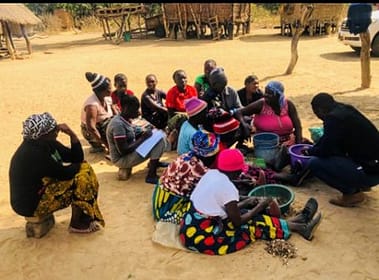THE COLANDS PROJECT
The integrated landscape approach as used under the COLANDS project is concerned with different drivers of the landscape of Kalomo ranging from deforestation, agriculture, water, wildlife to economic activities. The main drivers include deforestation, land encroachment, siltation and many more drivers such as expansion for agriculture land. This is leading to the opening up of forests for new agriculture lands, land alienation or intensity of agriculture activities (land exhaustion), charcoal production, land expansion for settlements and infrastructure development


The targeted groups and individuals that have been identified for the COLANDS project included chiefs, village headmen, school head teachers, community cooperatives, civil society Organizations, government, non-governmental organizations and private entities like (SEEDCO). The groups comprise different people with different social status at village, community and district levels whose interests are vast. The identified groups cover or are closely related to the CBNRM approach and landscape approach of the COLANDS projects. These range from Land rights, governance, policy and integration of various policies that have landscape approach components to community benefits. The identified stakeholders go as far as ensuring socio-economic costs are improved and the technical aspects of the project dynamics are well understood by the beneficiaries. These identified stakeholders are of positive influence to the COLANDS project especially the policy makers, government institutions (Ward development committee) and the traditional leaders (Royal establishments). Whilst the non-governmental organizations and private entities are being viewed as very important especially in influencing change to the government and articulating technical issues. Despite all these characteristics these stakeholders from the non-governmental sector are less influential on the COLANDS project due to their limits in their mandates.
The other attributes of the current levels and interface of interactions are generally low and are loosely defined which require changes in mind set, attitude, understanding of the CBNRM and landscape project approaches. Through stakeholder and social network analysis, the project can adequately address these challenges if it can capitalize on the strong interest and general liking for the project by the stakeholders. This calls for more dialogue to reach a consensus especially for the grass root Organisations in the chiefdoms on the COLANDS project. Not really that the project will achieve this through a multi-stakeholder approach dialogue to minimize conflict and build trust but also ensure transparent, inclusive and accountable governance of the stakeholder engagement process. Several individuals, groups and tools like KII, surveys and focus group discussion will be used for strong partnerships, networks and platforms. The forum also needs to involve all the chiefdoms in its implementation for the success of the projects and the Ward development committee so as to address issues of governance, responsibility, cost benefit analysis, policy integration and legal issues especially on community land boundaries.

Activities Implemented as Follows
This report highlights the outcomes of the awareness meetings on community rights, responsibilities, relationships and returns under the integrated land assessment and natural resources management that were conducted in Mudenda, Kaingu, Manthanyani and Siabalumbi villages located in Chikanta, Siachitema and Sipatunyana chiefdoms respectively in Kalomo District.
